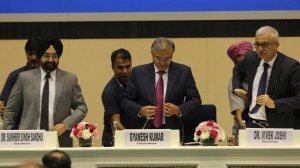US President Donald Trump arrived in Japan as part of a whirlwind week of diplomacy in Asia, landing in Tokyo on Monday and meeting with Japanese Emperor Nauruhito ahead of a bilateral summit today with new Prime Minister Sanae Takaichi.
Trump had earlier described Takaichi as a person with “great strength and wisdom”. Takaichi’s ability to establish a good working relationship with Trump is being carefully tracked here as an early test of her leadership.

Trump landed from the Malaysian capital, Kuala Lumpur, after attending a summit for the Association of Southeast Asian Nations on Sunday, and is then headed from here to South Korea, where his itinerary includes a much-anticipated meeting with his Chinese counterpart, Xi Jinping, in the last leg of his Asia tour.
Story continues below this ad
Takaichi has to hit the ground running, given that both sides are keen to wrap up a tariff deal negotiated by her predecessor Shigeru Ishiba. Ishiba had picked one of his closest allies and busiest ministers, Ryosei Akazawa, to be the man in charge of negotiating tariffs on Japanese goods. By retaining Akazawa as chief tariff negotiator, Takaichi has clearly placed her bet on experience and continuity. Tokyo is also keen to secure US backing against China.
Takaichi’s links to the late former PM Shinzo Abe, who shared a good rapport with Trump, is being seen as a net positive for the new premier. Abe famously used rounds of golf at Mar-a-Lago to earn Trump’s confidence.
In her first speech in the Diet (the Japanese parliament), Takaichi had promised to hike Japan’s defence budget to 2 per cent by the end of this fiscal, something that is broadly in sync with Trump’s expectations from countries dependent on the American security umbrella. The US President has flagged this point multiple times earlier and is expected to push Tokyo to contribute more towards US troop deployments – Japan currently hosts the largest number of American forces abroad, at well over 52,000 (South Korea has under 30,000 US troops in comparison).
But trade is what seems to matter the most in this new relationship, given that the deal with the US is of considerable interest to Japan’s auto majors – Toyota, Honda and Nissan. This is because the deal signed by Japan effectively pruned US import duties on Japanese cars from 27.5 per cent to 15 per cent. This potentially makes Japanese cars getting into the US more competitive against Chinese rivals.
Story continues below this ad
In return, Japan has pledged to invest $550 billion in America in sectors such as pharmaceuticals and semiconductors. Meanwhile, Trump’s announcement that Japan will hike purchases of American farm products, including rice, has unsettled Japanese farmers. The fallout of that is something that Takaichi will now have to grapple with.
Under the proposed US-Japan trade deal, which Trump referred to in July as “the biggest deal ever made”, the Americans had agreed to impose a 15 per cent “reciprocal tariff”, compared to the 25-27.5 per cent the US had threatened earlier. While most of the focus of the US-Japan deal has been on how Washington DC managed to get market access for American agricultural products, including politically sensitive items such as rice, what the Japanese managed to wrangle out is the best possible deal for its auto sector in the given circumstances.
According to the final deal, Japanese automakers would face a 15 per cent tariff now when entering the US market, much less than the global tariff on cars imposed by the US. The Big Three automakers in America – GM, Ford and Stellantis (essentially Chysler) – had subsequently protested, because, as they see it, the Japanese now have a clear tariff advantage.
After this trade deal, cars and car parts from Japan can get into the US after paying the 15 per cent tariff while American car makers, most of whom import a lot of cars and car parts fully assembled and manufactured in Canada and Mexico, are currently paying a 25 per cent tariff to import cars and parts into the US market from these two countries.
Story continues below this ad
For Japan, the country’s automotive industry is a big contributor to its economy, representing about 10 per cent of the country’s GDP and nearly 20 per cent of its manufacturing GDP. Automobiles are among Japan’s biggest exports and the sector’s performance is crucial for the country’s overall economic health. And when it comes to Japan-US trade, where Tokyo has a substantial surplus, it is in the auto sector where Washington DC faces most of its trade deficit. The bilateral meeting also comes up as one of the biggest auto exposition, the Japan Mobility Show, gets underway here from Wednesday.
The Japanese negotiators led by Akazawa made some eight trips to Washington DC up to end-July to get a deal that is favourable to them. While they did end up making a sizable commitment to investment in the US, alongside the concessions on the agri side involving rice and other farm products, the big prize really was auto. And that’s where the Japanese negotiators have maxed out the outcomes, which could set the stage for more Toyotas and Hondas flowing into the American market.
Interestingly, while the Americans had gone to town describing the deal as a big win, citing both the $550 billion investment pledge and agri market access as wins, the Japanese have maintained a studied silence in the aftermath of the deal, despite immense political pressure then on the embattled Ishiba government after the bruising electoral setback in July.
What the Japan deal means goes beyond basic numbers, since there’s a personal connotation here for Trump. For a man who is generally fickle with his views, tariffs are an issue where Trump’s been uncharacteristically consistent. And Japan was at the centre of Trump’s protectionist worldview in his early years, when the American businessman was still formulating his views on policy matters such as trade.
Story continues below this ad
In 1987, long before he voiced any intention to run for public office, Trump took out a full-page newspaper ad warning that Japan was “taking advantage” of the US, while pointing to the massive trade deficit between the two countries. Like most things with Trump, this was essentially a personal issue, which likely stemmed from the fact that the real estate developer had, just a few days prior to these ads, lost out on a bid for a grand piano in New York to the representative of a Japanese trading house. His views on tariffs have endured through these years, even though there is very little economic logic to the imposition of large scale tariffs by a country like America. Automakers from Japan, Trump said in that ad, were ripping America off. It’s a full circle now, when, ironically, Japanese carmakers seem to be big beneficiaries under the trade deal that Japan signed up in July under Trump’s watch.
This is especially so, given the comparative advantage that the Japanese carmakers seem to have uptill now, when the Chinese burst into the scene with their EVs. All eyes are now on what happens in the talks between Trump and Xi in Seoul.
(The writer is in Tokyo on the invitation of Suzuki Motor Corp)

































